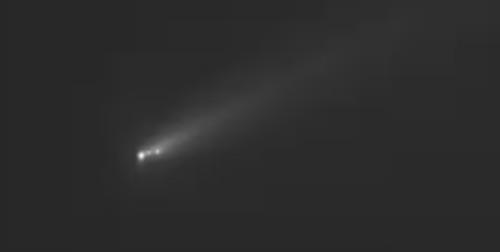
Comet C/2025 K1 to make its closest approach to Earth in December
The night sky has always been a source of fascination for humans, with its countless stars, planets, and other celestial bodies. Among these, comets have always held a special place, with their bright tails and unpredictable orbits. One such comet, C/2025 K1 (ATLAS), has been making headlines recently due to its unique behavior. Fragments of this comet, which split into three after passing too close to the Sun, are currently visible in the constellation Leo. The surviving debris of the comet will make its closest approach to Earth on December 25, passing at a distance of around 37 million miles (60 million kilometers), roughly half the average Earth-Sun distance.
Comet C/2025 K1 (ATLAS) was first discovered in May 2025 by the Asteroid Terrestrial-impact Last Alert System (ATLAS) survey. Initially, it was thought to be a single comet, but as it approached the Sun, it began to break apart, splitting into three distinct fragments. This phenomenon is not uncommon, as comets are known to be fragile and prone to fragmentation, especially when they pass close to the Sun. The intense heat and gravitational forces of the Sun can cause the comet’s icy surface to vaporize, leading to a breakdown of its structure.
The three fragments of Comet C/2025 K1 (ATLAS) are currently visible in the constellation Leo, which is located in the northern hemisphere. The fragments are moving at a relatively slow pace, making them visible for an extended period. Amateur astronomers and stargazers can observe the comet using binoculars or a telescope, although the visibility may vary depending on the location and weather conditions.
The closest approach of Comet C/2025 K1 (ATLAS) to Earth is scheduled to take place on December 25, when it will pass at a distance of around 37 million miles (60 million kilometers). This distance is roughly half the average Earth-Sun distance, which is approximately 93 million miles (149.6 million kilometers). Although the comet will not be visible to the naked eye, it will be an exciting opportunity for astronomers and space enthusiasts to study the comet’s behavior and composition.
The study of comets like C/2025 K1 (ATLAS) provides valuable insights into the formation and evolution of our solar system. Comets are thought to be remnants from the early days of the solar system, containing frozen gases and dust that date back to the time of the solar system’s formation. By analyzing the composition and behavior of comets, scientists can gain a better understanding of the solar system’s history and the processes that shaped it.
In addition to its scientific significance, the passage of Comet C/2025 K1 (ATLAS) also offers a unique opportunity for astronomers to test their theories and models. The comet’s fragmentation and closest approach to Earth will provide a rare chance to study the effects of gravitational forces and solar radiation on a comet’s structure and behavior.
In conclusion, the passage of Comet C/2025 K1 (ATLAS) is a significant event that offers a unique opportunity for scientists and astronomers to study the behavior and composition of comets. The comet’s closest approach to Earth on December 25 will be an exciting moment, and astronomers around the world will be eager to observe and study this phenomenon. Whether you are a seasoned astronomer or just a stargazer, the night sky has always been a source of wonder and fascination, and the passage of Comet C/2025 K1 (ATLAS) is a reminder of the awe-inspiring beauty and complexity of our universe.






